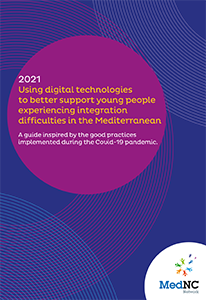Digital technologies to improve support for young people
The MedNC network publishes a guide based on good practices implemented during the health crisis.
The year 2020, with its multiple confinements, its school closures, and their consequences on the school dropout of thousands of young people worldwide, has manhandled the education systems of many countries. However, this unprecedented situation has led many vocational training and integration actors to seek, and often to find, innovative solutions to continue to support young people in spite of the circumstances, notably through the use of digital tools. These are some of these solutions that the MedNC network has assembled in the guide that appears today.
Entitled “ Using digital technologies to better support young people experiencing integration difficulties in the Mediterranean“, this document offers integration and vocational training professionals tips and ways to deepen or develop their uses of digital tools in their accompaniment activities.
Looking beyond the health crisis
Although this guide was created in the particular circumstances of the Covid-19 pandemic, the practices, tools and recommendations proposed in it are intended to apply in more ordinary contexts.
Far from presenting digital as a single and absolute solution, or advocating distance-only teaching, this document intends instead to complement the modalities of presentiel support by taking advantage of the interactivity and dynamism offered by the new technologies.
Among other, it is question of using video and audio not only to disseminate training content, but to create fun and innovative continuous controls modalities, which will enable them to mobilize other skills. Or the use of an interactive quiz platform to allow students to revise their theoretical knowledge beside of school hours, in a more engaging way.
Digital: a source of opportunity but also and above all inequality
New technologies are bringing ever-increasing challenges to the integration and employability of young people. The sectors linked to new technologies remain extremely promising – particularly in the countries of the southern Mediterranean – while the lack of basic digital skills is an increasingly systematic barrier to employment.
To the extent that it outlines the main needs for digital equipment and skills; and suggests initiatives to be supported, we hope that this guide will also resonate with technical and financial partners.
What’s in the guide?
This guide is the result of extensive consultation conducted in the summer of 2020 with MedNC partners and members, as well as several IECD program around the world.
It is built around four main themes: equipping yourself and your beneficiaries with connected equipment; acquiring digital skills; staying in touch despite the distance and integrating digital technologies in your training modules.
For each of them, it presents: good practices and feedback from concrete experiences, proposed by the interviewed field actors ; digital tools of all kinds: software, resources platforms, websites, and applications; that address these issues. These can also be found in a dedicated Excel file.
Our hope is, of course, that these resources can be useful to as many people as possible, and modestly contribute to better digital inclusion, and integration of young early school leavers in the Mediterranean region, and beyond.
Our thanks go to the Drosos Foundation (www.drosos.org) whose support made this publication possible.



